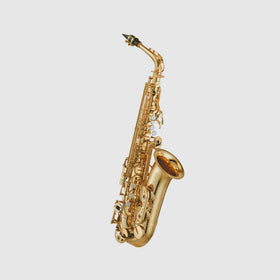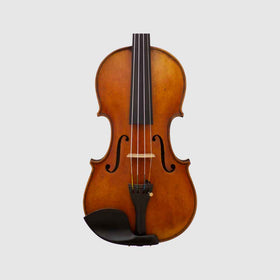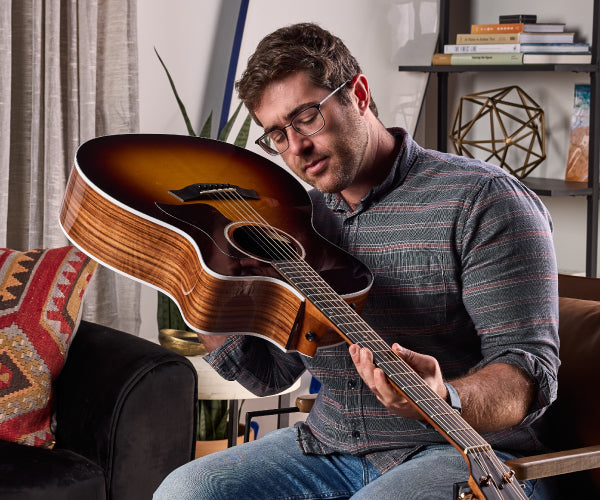Humidity Basics
The significance of humidity and its impact on instruments is frequently underestimated by customers and even by other music stores. Our dedication lies in enlightening players about this matter and guiding them on effectively managing humidity levels to maintain your guitars in optimal playing condition.
Due to the hygroscopic nature of wood, it has the tendency to absorb moisture in humid environments or release moisture in dry conditions, leading to changes in its size. This phenomenon affects all wooden instruments and other wood-based items.
Relative Humidity (RH)
Relative Humidity (RH) is quantified on a scale ranging from 0% to 100%. It indicates the amount of water vapor present in the air relative to its maximum capacity to hold moisture. For instance, 50% RH implies that the air contains half the amount of water vapor it can potentially hold.
RH is also influenced by temperature, as higher temperatures enable the air to retain more water vapor. In colder seasons when heating systems are utilized, increasing the temperature leads to a decrease in RH, which is a common occurrence. Conversely, RH typically rises during overnight hours as temperatures cool down, adhering to the general principle. To obtain accurate RH measurements, it is imperative to employ a dependable hygrometer.
Sustained low levels of relative humidity (RH) can lead to physical alterations in a guitar. It is crucial to familiarize oneself with these indications and regularly monitor the condition of your guitars. Taking appropriate measures becomes necessary to prevent significant damage. Solid-wood instruments reach their optimum structural and sonic state when maintained at the same RH level as during their construction.
Reputed manufacturers such as Taylor Guitars maintain their factory environments at approximately 50% RH. A safe range is within a 5% margin, between 45% and 55% RH. Maintaining appropriate RH levels, even in arid desert regions, can be achieved with the assistance of modern humidification systems and products.Symptoms of a Dry Guitar
Extended exposure to low relative humidity (RH) conditions can result in the contraction of wood in a guitar. Several indicators serve as warnings that a guitar is starting to experience dryness.
Structural Symptoms Caused by Low RH
- Sharp Fret Ends - The fretboard shrinks but the metal frets do not, causing the fret ends to protrude.
- The sides of the nut extend over the nut slot.
- Bridge Lifting - Shringkage of the top may cause the brdige glue joint to come loose.
- The binding shrinks and/or cracks on the neck or body.
- The fret ends protrude and feel sharp, making the guitar uncomfortable to play.
Playability Issues Caused by Low RH
- Action becomes too low or lower than normal; buzing occurs.
- The saddle would need to be raised to have same action as before.
- The guitar's tone changes as the geometry shifts and the wood becomes more brittle.
- The fret ends protrude and feel sharp, making the guitar uncomfortable to play.
Symptoms of a Wet Guitar
High RH (above 50%) for prologned periods can also lead to significant damage, which can be just as harmful as low RH.
Structural Symptoms Caused by High RH
- The instrument has extremely high action and is hard to play.
- Finish pops off or lifts
- The Bridge corner lift.
- Fogging in the finish.
- Mold forms inside the guitar body.
- Water stains inside the guitar body.
- Binding separation in waist, bouts and/or cutaway areas.
- Extreme arch in the top and back.
- The top and back swell, causing "pinching" at the tail block.
Guitar Humdifiers
Sponge-Style
In case you are uncertain about the humidity level of your instrument and its case, there exists a straightforward and efficient method to assess it using a sponge-style humidifying device like the ones manufactured by D'Addario. We refer to this method as the "24-Hour Rule."
The 24-Hour Rule
- Soak the sponge in room temperature water in a sink or in a bowl.
- Wring out the sponge completely so that no water drips out of the sponge. (For Planet Waves, put the sponge into the device only after water has been completely wrung out.) If dripping water is left in the sponge, it will damage the instrument. We don't want to add water to the guitar, just water vapor (evaporated water).
- Wipe off any excess water from the outside of the sponge units with a towel.
- With the guitar in the case, install the humidifier between the D and G strings of the instrument, then close and latch the lid tightly. (The Damp-it will sit inside the instrument while attached to the strings). Do not cover the soundhole.
- After a full 24 hours, open the case and check the humidifier. If the sponge is soft and pliable and still contains water, the guitar is at the proper humidity level. If the sponge is dry, hard, and not pliable, repeat all the above steps, and check again 24 hours later.
- Continue the process until the sponge retains water after a 24-hour period.
This procedure ensures that the humidity level of the case and guitar are most likely where they need to be. In order to maintain this humidity level, you may need to repeat the procedure on a weekly or monthly basis, depending on the season and the climate where you live.
Alternatives: Humidipak
Apart from sponge-style guitar humidifiers, there exists a variety of other highly effective products designed to control humidity specifically for guitars.
Humidipak stands out as a unique reverse-osmosis product designed to uphold a consistent humidity level by regulating moisture absorption and release. Its usage is incredibly simple: just place it inside the guitar case, and it operates automatically.
To utilize it, carefully open the outer cellophane wrapper, ensuring not to damage or tear the white packets enclosed within. Next, insert the packets into the black mesh holding pouches, and position all three pouches inside the guitar case. Humidipaks are available in two different humidity options: 48% RH for regular use and humidity maintenance, and 72% RH, utilized by service technicians for re-humidifying instruments that have dried out.
For optimal performance of the Humidipak system, it is essential to ensure that the instrument and case are adequately humidified before installing the Humidipaks. The standard 48% packets are not intended for re-humidifying a completely dried-out instrument. (Although they will eventually achieve this, the packets will quickly dry out and require frequent replacement.) If re-humidification is necessary, always employ the 72% packets or a water-based humidifier.
Room Humidifiers
When guitars are showcased or not stored in cases, free-standing humidifiers serve as a suitable choice. The most efficient units are equipped with sensors that monitor the humidity level and activate automatically when the RH drops below the desired setting. It is important to consider the room size when selecting a humidifier.
The humidifier's capacity should match the number of cubic feet of air space in the room. A significantly small humidifier will struggle to maintain the appropriate RH level in a large room. As a general guideline, it is advisable to opt for a humidifier with a capacity that surpasses the size of the room.
Positioning the Humdifier
The humidifier should never be placed underneath the instruments or close to instruments. This can over-humidify the area immediately around the guitars. A corner or central spot away from instruments will work best.
Hygrometers
It is essential to utilize at least one hygrometer to comprehend the conditions within the room you aim to humidify. Hygrometers are available in various sizes and price ranges, with most being effective in offering the necessary information to maintain the room at an ideal level for instruments.
For the most accurate results, we recommend using a digital hygrometer. Digital hygrometers can be purchased within a price range of $30.00 to $200.00. Tarpley Music advises against analog hygrometers due to their tendency to be less accurate and prone to providing false readings.
Positioning the Hygrometer
To ensure comprehensive humidification coverage throughout the room, it is recommended to position the hygrometer opposite the humidifier. This placement helps to monitor the humidity levels in the entire space. In larger rooms, it may be necessary to utilize two hygrometers to obtain accurate readings across the entire area. For humidifiers that include a built-in humidity sensor, Taylor suggests using a second hygrometer placed on the opposite side of the room to achieve the most precise and reliable reading.
The Guitar Case
If you lack a room suitable for humidification, it is not advisable to leave the instrument exposed on a stand or display. Fluctuations in humidity caused by heating and air conditioning systems can potentially harm guitars. The optimal location for the instrument when it is not being played is inside its case.
Premium guitar cases are specifically designed to maintain humidity, provided that the appropriate level of moisture is introduced into the case. By utilizing the aforementioned products mentioned earlier, both the guitar and the case can be set to the correct relative humidity (RH) levels. These products essentially establish a humidified environment within the guitar case.




